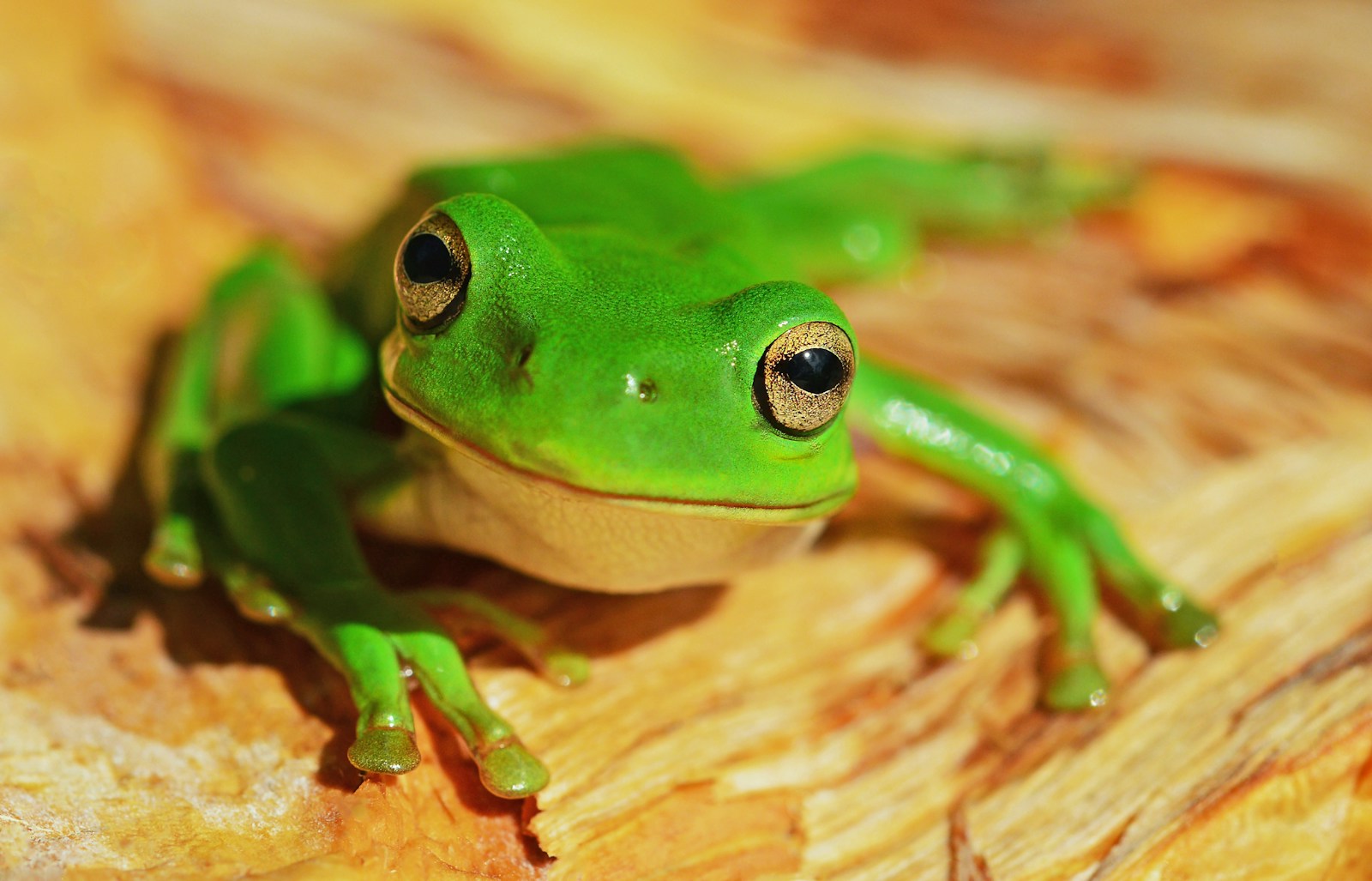Have you ever noticed how many frogs are green? It’s like, that’s the frog color, right? But it’s not just a random choice of paint job. That green actually plays a super important role in how they live. From blending in with their environment to some cool biological tricks, there’s a lot more to froggy green than meets the eye. So, let’s explore why so many frogs are green and what that color means for them.
Camouflage and Survival
The primary reason many frogs are green is camouflage. Frogs that live in environments rich in vegetation, such as forests, wetlands, and grasslands, benefit from having green skin that allows them to blend seamlessly with their surroundings. This natural camouflage makes it difficult for predators like birds, snakes, and mammals to spot them. For many frog species, blending in with leaves, moss, and other green elements is essential for avoiding predation and surviving in the wild.
Example of Camouflage in Action
In dense forests or tropical rainforests, green tree frogs can easily go unnoticed as they rest on leaves or branches. The green color not only matches the foliage but also helps break up their outline, making it harder for predators to detect their presence.
Biological Pigmentation and Structural Colors
The green color seen in frogs is the result of complex biological processes involving pigmentation and structural colors. Frog skin contains specialized cells called chromatophores that produce and manipulate colors. There are three main types of chromatophores involved in creating the green coloration:
- Xanthophores: These cells are located in the upper layers of the skin and contain yellow and orange pigments.
- Iridophores: Situated beneath the xanthophores, these cells reflect light, giving the skin a blue or white appearance due to the scattering of light.
- Melanophores: Located in the deeper layers of the skin, these cells contain dark pigments that can enhance or modify the overall color.
The green color in frogs is typically created when the blue light reflected by the iridophores passes through the yellow pigments in the xanthophores. This combination of blue and yellow produces the characteristic green hue seen in many frogs. The exact shade of green can vary depending on the density and arrangement of these chromatophores, as well as the specific habitat in which the frog lives.
The Science Behind Chromatophores
The fascinating interplay between these chromatophores allows frogs to adapt their coloration not just for camouflage but also for communication. In some species, the ability to change shades can be crucial during mating seasons or territorial disputes, making these tiny cells a powerhouse of amphibian survival strategy.
Adaptation to Environmental Niches
Over millions of years, frogs have evolved to adapt to their specific environments, and coloration is a key aspect of this adaptation. Frogs that live in lush, vegetated areas are more likely to develop green skin because it provides an evolutionary advantage. Those that can avoid predators by blending into their environment have a higher chance of survival and reproduction. As a result, natural selection favors green coloration in frogs living in these habitats, leading to the prevalence of green frogs in certain regions.
Evolutionary Advantage
In ecosystems where green vegetation dominates, frogs with green skin are less likely to be spotted and eaten by predators. This evolutionary pressure has resulted in the widespread presence of green coloration among frog species that live in areas such as rainforests, swamps, and grasslands.
Temperature Regulation and Water Retention
Although camouflage is the primary function of green coloration, some researchers suggest that the pigments involved in producing green skin might also play a role in temperature regulation and water retention. The color and structure of frog skin can influence how much heat they absorb or reflect, which is important for cold-blooded animals like frogs. Additionally, the skin’s properties might help minimize water loss, which is crucial for amphibians that rely on moist environments to stay hydrated.
Role of Skin Structure
Frog skin is not only responsible for coloration but also serves as a key barrier against water loss and temperature fluctuations. The combination of pigments and reflective structures in green-skinned frogs may help regulate body temperature by either absorbing or reflecting sunlight, depending on the environmental conditions.
Communication and Mating
While green coloration is primarily linked to camouflage, it may also have a role in communication and mating among certain frog species. In some cases, the intensity or brightness of a frog’s green coloration can signal its health or fitness to potential mates. Bright, vibrant colors can be an indicator of a well-nourished and genetically strong individual, making them more attractive to potential partners.
Example of Mating Displays
In species where color plays a role in mating displays, brighter green hues might help males attract females. The ability to maintain such vivid coloration could be a sign of a frog’s overall health and ability to thrive in its environment, making it more appealing during the breeding season.
Adaptability Across Species
Not all green frogs are the same shade of green, and not all frogs that live in vegetated areas are exclusively green. Some species have evolved to display a range of green hues, from bright lime green to deep olive. This variation allows frogs to adapt to different types of environments, from tropical rainforests to temperate woodlands. In some species, the green coloration may be mixed with patches of other colors, like brown or black, further enhancing their ability to blend into their surroundings.
Case Study: The Red-Eyed Tree Frog
The red-eyed tree frog is a classic example of a species that uses green coloration for camouflage. While the frog’s primary body color is a vibrant green, it also has striking red eyes and blue or yellow markings on its sides. During the day, when the frog is at rest, it tucks its bright legs and eyes into its body, effectively camouflaging itself against green leaves. When threatened, it opens its eyes wide and flashes its colorful legs to startle predators, giving it a chance to escape.
The Role of Human Perception
Interestingly, the perception of color by predators and humans can vary significantly. While we might see a frog as bright green, certain predators might see it differently due to variations in visual systems across species. This discrepancy can enhance the effectiveness of the frog’s camouflage. Furthermore, human activities and our impact on environments can alter these dynamics, sometimes to the detriment of frog populations.
Conservation Implications
The color and camouflage abilities of frogs are not just biological curiosities; they are vital for their survival. However, deforestation, pollution, and climate change threaten these delicate ecosystems. As environments change, the green camouflage that once provided impeccable cover might become less effective, leading to increased predation and reduced frog populations.
Practical Steps for Conservation
To help protect these fascinating creatures, conservation efforts should focus on preserving natural habitats and mitigating climate change. Supporting reforestation projects, reducing pesticide use, and advocating for policies that protect wetlands can help maintain the environments that green frogs rely on.
The Future of Frog Coloration
Looking forward, the evolutionary path of frogs may continue to shape and be shaped by their coloration. As environments change, so too might the pigmentation and adaptability of frog species. Some scientists are investigating whether frogs might develop new color adaptations as a response to rapid environmental changes.
Encouraging Biodiversity in Your Backyard
If you’re keen on supporting frog populations and their vibrant colors, consider creating a frog-friendly environment in your backyard. A small pond, native plants, and a lack of chemical pesticides can create a haven for local amphibians. This not only supports biodiversity but also offers a delightful glimpse into the lives of these remarkable creatures.
Common Mistakes to Avoid
When attempting to create a frog-friendly space, there are a few pitfalls to watch out for. Avoid introducing non-native plant species, as they can disrupt local ecosystems. Also, steer clear of using any chemical fertilizers or pesticides, as these can be harmful to frogs. Instead, focus on natural pest control methods and native plant species to create a balanced and inviting habitat.
Conclusion
The green coloration in frogs is a fascinating example of how evolution, biology, and environmental factors work together to ensure the survival of a species. Green frogs are a testament to the importance of camouflage in nature, allowing them to evade predators, adapt to their environments, and thrive in diverse ecosystems. Beyond camouflage, the green color is a result of complex pigmentation and structural color mechanisms within the skin, showcasing the intricate design of amphibians. From a biological standpoint, the combination of pigments and light-reflecting structures in frog skin is a marvel of nature, demonstrating how specific adaptations evolve to meet environmental challenges. Whether serving as a means of blending into lush foliage, regulating temperature, or enhancing mating displays, the green color of many frogs is a critical factor in their survival and success in the wild.




